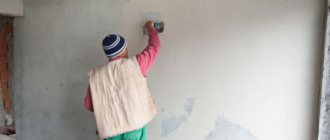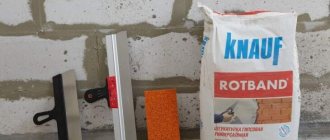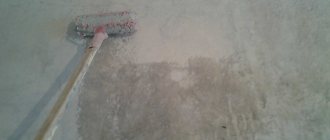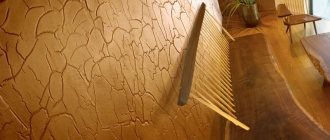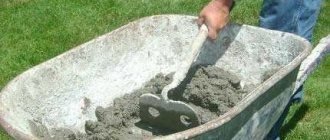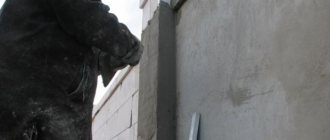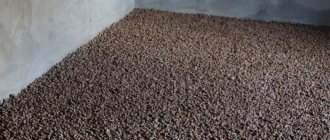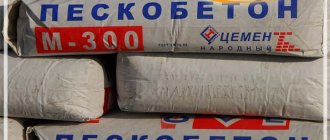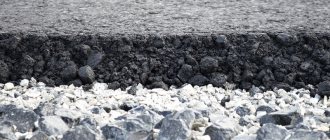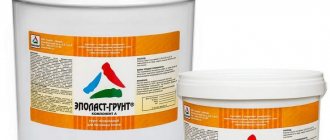What it is
Decorative plaster "bark beetle" is a material for facade finishing, which has a unique pattern, a bit reminiscent of tree bark, chewed by insects.
Decorative bark beetle plaster, the consumption of which we will need to accurately calculate, is a white powder with a grayish tint. Most of all, the substance resembles cottage cheese in its ready-to-use form.
The powder, the consumption of which must be calculated per 1 m2, has inclusions in the form of granules. They largely determine the final appearance of the facade. Typically the granule size is about 2.5 mm.
Advantages
Decorative plaster “bark beetle”, the consumption of which we need to calculate per 1 m2, has a number of important advantages that determine its use when finishing the facade:
- The mixture contains mineral additives and polymers. Thanks to this, the substance has increased viscosity. As a result, adhesion to the application surface is enhanced.
- Environmentally friendly. Decorative plaster “bark beetle”, the consumption of which must be calculated per 1 m2, does not contain toxins.
- Light weight. Unique components with a high level of protection for walls can reduce the load on them.
- No shrinkage. When applied to 1 m2, the bark beetle does not shrink.
- High impact resistance. The walls can easily withstand mechanical loads of varying intensity.
- Frost resistance and ultraviolet resistance. Bark beetle plaster, when applied to every square meter of surface, can withstand temperatures down to -55 degrees Celsius. Moreover, the sun's rays cannot harm it in any way.
- Walls covered with bark beetle plaster can be washed with chemicals. But before this, it is necessary to calculate the consumption of the substance per 1 m2.
- High level of vapor permeability. If you correctly calculate the consumption per 1 m2, you will get a so-called breathable surface. Thanks to this factor, it will be possible to avoid the formation of fungus. This will extend the life of the building.
- Walls treated with bark beetle plaster can be easily painted in any color. In this case, the paint will last for a long time. Although this finishing method is not the most effective. It is better to dissolve the pigment in the solution from the very beginning. But before that, of course, you need to calculate the consumption per 1 m2.
- Using the “bark beetle” you can treat interior walls. This will provide a unique decor inside the room.
- Affordable price. Bark beetle plaster cannot be called cheap, but its price is more than acceptable, especially for the segment of finishing decorative materials. Moreover, if you calculate the consumption correctly, you will save money.
This is not a complete list of the advantages that bark beetle plaster has, but they allow us to understand why this mixture is so popular among both amateur builders and professionals.
Marking
The consumption of decorative bark beetle plaster per 1 m2 largely depends on the marking. Depending on the granules, the scope of use of the substance is determined. Marking K15 means the size of one granule is 1.5 mm, K35, respectively, 3.5 mm.
Attention! The size of the fractions ranges from 0.8 to 3.5 mm.
Fine-grained mixtures are used when it is necessary to create interior finishing. Of course, in this case it is necessary to correctly calculate the consumption of bark beetle plaster per 1 m2. In turn, a substance with granules of larger fractions is excellent for facade work.
The size of the fractions largely affects the consumption of decorative plaster per 1 m2. The larger the granules, the higher the consumption. This must be taken into account when making calculations. For example, if we are talking about material with 2 mm granules, then one square meter will take approximately two and a half kilograms. But this figure may fluctuate depending on the parameters.
Attention! Plaster with smaller granules costs more.
Pattern Formation
You now know the consumption rates of Bark Beetle plaster per 1 m2. But you also need to take an interest in the technology for forming this or that pattern. Using a trowel or trowel, the plaster must be leveled. The nature of the pattern will depend on the movements. With vertical movements you can form a surface called rain. When the tool moves horizontally, this will allow you to get stripes. A chess pattern can be formed by moving your hand in a criss-cross pattern.
You can get a frosty pattern using wavy and circular movements. When grouting the surface with a polystyrene foam trowel, you can get a “plug” if you move the tool in a circular motion with a small amplitude. Within three days maximum the plaster will dry. The time can be reduced to two days and will depend on the temperature. In this case, drafts should be avoided inside the room. After 3 days, the surface can be coated with acrylic varnish or painted.
Calculation
As mentioned above, the consumption of bark beetle plaster per 1 m2 largely depends on the size of the granules. Despite this, there is some average figure. On average, it can take from 2.4 to 10 kilograms per square meter. In this case, the thickness of the layer is also taken into account.
Moreover, the technology for manufacturing the substance varies from manufacturer to manufacturer. Therefore, the best option would be to take into account the data indicated on the packaging. In this case, it is necessary to add about 10 percent on top.
As an illustrative example, let’s take a layer of plaster 10 mm thick. To apply it to the wall you will need at least 6-7 kilograms of bark beetle. Provided that the manufacturing company is Volma.
But if you take decorative bark beetle plaster as a consumable material and calculate the consumption per 1 m2 for the same layer, it will be about 9 kg. Simply put, if you want to decorate a room of 30 m2, then you will need about 270 kg.
Calculation method
There are a number of factors that affect the consumption of substances, among the most significant are the curvature of the walls and the type of building mixture. But the most important thing is the thickness of the layer with which you want to cover the wall.
To correctly calculate the thickness, it is necessary to install beacons. For this you will need a level. Now you can take measurements even on a curved surface.
When all the measurements are collected, you need to add them up and divide by the number of points. This indicator will be the main one when determining the thickness. For a better understanding, let's take a specific example.
Let's imagine that you need to process 10 m2 of area. The degree of collapse is 5 cm. The lighthouses are located in three places. Accordingly, the deviation is 2, 4 and 6 cm.
Add these numbers and divide the result by three. The result of the calculations will be the number 4. This is exactly the thickness of the layer of bark beetle plaster that you will apply to the walls.
When we know the thickness of the layer, we can begin to calculate the consumption per 1 m2 and the general indicator. It is best to use the information on the packaging. As an example, let's take the Knauf Rotband bark beetle plaster. To process one square meter 10 mm thick, at least 8.5 kg of dry mixture is required.
Having basic indicators, you can easily calculate the consumption per 1 m2 with a layer thickness of 4 cm. For processing you will need exactly 34 kilograms. But since the area of the room is much larger, we multiply this figure by 10 and get 340 kg. At the same time, do not forget about 10 percent as a reserve. The result of the calculations will be the figure 374 kg.
Now regarding the number of bags required to process not 1 m2, but 10. Usually Knauf Rotband is packaged in 30 kg packs. To make high-quality plaster in a room you will need at least 13 bags.
Calculation method
The method for calculating the consumption of bark beetle plaster per 1 m2 differs significantly from the method of determining the need for conventional material for plastering work. The average value for one unit of surface area reaches 2.4 – 4 kg and directly depends on the thickness parameters of the applied solution.
Sometimes it is difficult to know the exact volume of material. In such cases, it is necessary to rely on information from the manufacturer, increasing the resulting value so that there is actually enough material.
Please note that bark beetle plaster mixtures from different manufacturers may differ in consumption, and this factor is always taken into account at the time of purchasing the material.
For example, the product is consumed at the rate of 6.5 kg per square area, but the mixture from “Prospectors” reaches 9 kg for a similar area.
Bottom line
However, if calculating the required amount of material is difficult for you, you can use one of the online consumption calculators. These programs allow you to calculate the required amount of material, provided that you have decided on the type, know the area of the walls being processed and the expected layer thickness.
We hope that the methodology presented in this material will be useful to you and when carrying out repairs, the question “How to calculate the amount of plaster?” won't confuse you! All we have to do is offer you a useful video in this article.
The most affordable and easiest way to level the walls is to plaster them. Before buying certain building materials, you need to know how much of them will be required for a given area. When starting work, we recommend making an accurate calculation of the plaster consumption per 1 m2, so as not to make a mistake in purchasing the required amount of consumables. Using our calculator to calculate plaster consumption, you will avoid delays in work and material waste that will inevitably arise when purchasing insufficient or too much mixture.
When filling out the fields of the online calculator, take into account the initial curvature of surfaces per 1 m2 (the layer of plaster depends on the parameter) and the type of materials used. When choosing a coating, it is important to know the consumption of plaster per 1 m2 for a particular type of base. Moreover, the consumption of decorative plaster will differ from the consumption of the main leveling mixture.
What is the consumption of bark beetle plaster per 1 m2
Due to its plasticity, the material is not subject to cracking and mechanical damage. Compositions that include silicone are more durable and flexible, which has a positive effect on the service life.
However, these modifications are also very expensive. Bark beetle plaster consumption per 1 m 2 is a relatively economical cladding option. However, for a more accurate calculation, it is necessary to make some manipulations and take into account one important factor - the desired thickness and diameter of the marble chips. For example, if plaster with a fraction size of 2 mm turns out to be a suitable cladding option for applying to a wall, then the material consumption will be about three kilograms per m2.
Applying bark beetle plaster is quite simple, but requires extensive preparatory measures before facing. The plastering process must be carried out exclusively on a flat surface, so the work requires a preliminary rough coating with ordinary facing material, several millimeters thick.
General principles for calculating flow
In general, to independently determine the expected level of plaster consumption, it is necessary to take into account two main factors that influence this criterion.
The first is the nature of the texture and the curvature of the walls on which the material will be applied. Any deviations horizontally and vertically will somehow affect the amount of material that will be needed to level the walls with a special coating.
The second, no less important, factor is the type of finishing material you choose. The consumption rate of plaster will be determined directly by its specific type. Having calculated the required amount of finishing material, you should also carefully calculate the required layer thickness.
For example, if you need to plaster 10 sq. m of wall, heaped evenly by 5 cm, mark the deviation points of 1, 3 and 5 cm. Having found the total arithmetic of these three indicators (that is, 3 cm, in this case), you will get the average thickness of the layer that will need to be applied to the entire surface. Only if all calculations are completed can you be sure of the rationality of choosing one or another type of finishing material.
As for ATLAS decorative coatings, we list the plaster consumption for some of them below:
- ATLAS CERMIT SN and DR - thin-layer mineral plaster, depending on the grain thickness, has a consumption of 2.5–4.0 kg/m²
- ATLAS CERMIT PS - thin-layer mineral plaster for cement and plasters, concrete, plasterboards, about 2.0 - 2.5 kg/m²
- ATLAS CERMIT N and R - thin-layer acrylic plaster, depending on the grain thickness, has a consumption of 2.5–3.0 kg/m²
- ATLAS SILKON N and R - thin-layer silicone plasters, from 2.5 kg/m²
We determine the consumption rates of façade plasters per 1 m2
Mineral plaster mixture Ceresit CT 137, thin-layer, decorative (pebble) is used for finishing facade walls insulated with polystyrene foam and mineral wool slabs. Supplied in 25 kg bags. Modifications of filler grain sizes of 1, 1.5 and 2.5 mm are used. If a brick façade wall is being processed, then 1.8 kg of ST 137 (1) will be required per 1 m2; 2.4 kg ST 137 (1.5) and 3 kg ST 137 (2.5).
Decorative plaster ST 35 (bark beetle) with a grain size of 2.5 mm consumes 2 kg, and with a diameter of 3.5 - 3 kg.
Acrylic plasters Ceresit ST 60, 63 and 64 are supplied ready-made in special 25 kg buckets. The average consumption is 2.6-3.8 kilograms per square meter. meter depending on the grain size of the mineral aggregate.
Silicate-silicone decorative plaster Ceresit ST 175. When material consumption per 1 m2, the diameter of the filler is also taken into account. The average value is 2.7 kg per meter of area. Silicone decorative plaster ST 75 is also used for finishing external walls. Consumption per sq. meter is 2.9 kg.
Plaster mixtures based on silicone and silicate-silicone - Ceresit ST 74 and 174. The material is supplied in 25-kilogram buckets in a ready-to-use form. As with other types of plasters, the volume of mixture used per 1 m2 greatly depends on the diameter of the filler. Thus, using the modification ST 174 (1.5) you will need 2.5 kg of the mixture. Whereas external work using ST 174 (2) will require 3.5 kg of solution per 1 m2.
Summarizing the consumption of facade plasters, we can conclude that on average 2 to 4 kilograms of the mixture are required to finish a wall with an area of 1 square meter. This is quite economical with high quality and durability of the resulting surface. In order to reduce the consumption of finishing mixtures, it is recommended to thoroughly treat the wall surface before application. First of all, remove all defects and irregularities and repair cracks. It would be a good idea to apply an acrylic primer, for example, Ceresit ST 16. This will increase the adhesion of the decorative plaster to the surface.
In the process of carrying out repair work, determining the required amount of plaster is associated with its consumption rates, which directly depends on the thickness of the layer applied to the load-bearing surface, the technical characteristics of the mixture and the area covered by the material.
What factors influence layer thickness?
The thickness of the applied plaster is a very important point that affects the service life of the wall or facade coating. The thickness of the applied layer will depend on several factors:
- The curvature of the walls is of great importance . Naturally, if the wall is quite uneven, then this significantly increases the consumption of this finishing material and, as a consequence, the thickness of the applied layer. Even if it is a building, it may have a deviation of 2.5 cm. Irregularities are determined using a building level.
- Also, the thickness of the layer is influenced by the type of façade plaster itself . Naturally, if it is necessary to plaster an external wall, then a special building material is used for such work, which is characterized by increased consumption when compared with plaster for interior work.
- The material from which the walls are made.
I would like to talk about the last factor separately. Each material from which the facade is made has its own characteristics and features, which naturally affect the consumption and thickness of the plaster layer.
The specific use of the material, application method and service life largely depend on the type. Let's consider each of them separately so that there are no conflicting opinions regarding the use of facade plaster.
Brick
A brick wall is characterized by the fact that it has a certain relief, which is explained by the spaces between the bricks filled with cement mortar. Read about brick plastering here.
If we assume that the brick wall is perfectly smooth, then the minimum layer of plaster should be about 5 mm.
There is also a maximum value - 5 cm, i.e. You cannot apply more than the thickness of this layer to the wall . And this is provided that the wall is supplemented with reinforced mesh.
If it is not there, then the maximum layer thickness is no more than 2.5 cm. Otherwise, cracks and chips may appear. If these standards are violated, there is a risk of destruction of the base, and the durability of the material is reduced.
Concrete
If the wall is far from ideal evenness, then the layer can be much thicker - about 7 cm . Naturally, such a thickness is only possible if reinforcing mesh is used. If you do not use a mesh, the maximum layer should be no more than 2 cm.
Aerated concrete
This material is in many ways similar to concrete, so the layer of plaster will be identical - from 2 to 5 mm . If the wall is uneven, then the maximum allowable layer should be 1.5 cm, but no more, because otherwise cracks may form on the surface. More details here.
Tree
Plaster adheres very poorly to a wooden surface, so this option is only possible if a metal mesh or wooden lathing is installed on the wooden surface. Plaster must be applied in stages. First, the layer should cover the grate completely, after which a second layer is applied, with the help of which the surface is already leveled.
How to calculate the consumption of facade plaster?
Correctly calculating the consumption of facade plaster will help you determine in advance the costs of exterior finishing and insulation. Which, in turn, will simplify and optimize overall control over the consumption of funds and materials. Although the ever-living Vladimir Ilyich argued that socialism is accounting, as it turned out, accounting is required not only at the stage of waiting for a bright future, but also in those times when this future is remote indefinitely.
To calculate the consumption of facade plaster, you need to know the total area of the facade and the consumption of the selected mixture per square meter. In fact, this is enough. But we should not forget about the nuances and little things, in which, as we know, the devil hides. There are factors that affect the consumption of facade plaster, significantly increasing or, conversely, reducing it. Knowing these factors, you can quite accurately calculate the required amount of plaster mixture. This article is devoted to the features of such a calculation.
Let's start the conversation with the purpose and features of facade plasters.
Why do you need façade plaster anyway? Maybe you can do without it? Sometimes it’s possible to get by. But it's not necessary. A layer of plaster, in addition to its decorative function (which in itself is very important!), performs many other tasks. Facade plaster protects the walls of the house from a variety of external influences:
- From moisture and water;
- From low temperatures in winter and scorching sun in summer;
- From chemical exposure (exhausts from cars, industrial enterprises, etc.);
- Prevents the spread of fire in case of fire;
- It also performs heat and sound insulation functions.
Previously, plaster was a rather thick layer of cement or lime mortar, to secure which a steel reinforcing mesh was sometimes mounted on the walls of the house. Modern technologies and the advent of thin-layer plasters have greatly simplified and facilitated this design.
Minimum consumption of facade plaster can be achieved when finishing and insulating buildings using the “wet facade” technology. With this technology, sheets of heat-insulating material (most often polystyrene foam) are attached directly to the wall of the building. And thin-layer plaster is already applied to it.
Textured plasters are often used to give the facade an aesthetically attractive appearance. The popularity of this technology is facilitated by a large selection of color schemes and the relatively low consumption of facade plaster, which, accordingly, leads to a reduction in finishing costs.
However, no matter how you save building materials and what technologies you use, a certain consumption of the plaster mixture will be inevitable. It is obvious. Let's consider what factors influence this consumption.
2. Factors determining the consumption of façade plaster
When applying plaster directly to walls, the main reason for increased consumption may be their unevenness. The finish should be close to ideal; accordingly, all unevenness of the base will have to be leveled out due to the thickness of the plaster layer.
The thickness of the plaster layer and its consumption also depend on the material from which the walls are made.
Brick - provided there is a perfectly flat wall made of brick, the thickness of the plaster layer cannot be less than 0.5 cm. If you have to level out the curvature of the walls, remember that the maximum permissible thickness of the plaster layer on brickwork is 5 cm. With a thickness of more than 2 .5 cm reinforcement mesh should be used. Do not neglect this rule to prevent destruction of the material!
